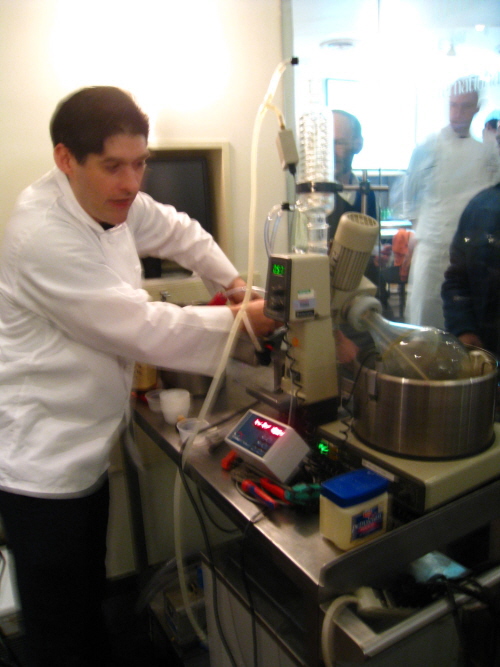posted by Nastassia Lopez

The cool thing about this job is that I get to sit in on the demos that Dave and Nils teach, eat delicious things, laugh a good majority of the time, and learn a hell of a lot about food tech. The second day with McGee was all about heat, the third day we learned new techniques and messed with flavors. There were a lot of awesome demos, but I’m going to highlight some of the cooler nuggets of info that I found interesting and applicable to the things I like to eat/cook.
Flipping Your Meat


When the steaks were “done” we ensured they were cooked to the same internal temperature by putting them in ziplock bags and circulating them for 30 minutes in 56 degree water. The class tasted. The ones that were flipped more frequently were more consistently even throughout, with a nice well-done crust on the outside. The ones flipped only once had a larger proportion of overcooked parts and didn’t even have a better crust—surprising.
Ike Jime Taste Tests

On day one of the class, fish were killed with three different methods to determine the effects of slaughtering on taste and texture:
1. Western Killing: allow to suffocate in air for 30 minutes and whack over the head.
2. Ike-Jime (spinal chord destruction): sever the spinal chord, shove a needle up the spine and bleed out.
3. Anesthesia plus Ike Jime: knock the fish out with clove oil and then do ike-jime (for the full blow-by-blow see post here).
On days two and three we blind tasted the fish that were killed on day one both raw and cooked. Dave and Nils were a tad worried about the demo because they had never done ike jime on blackfish, and weren’t sure how long rigor mortis would last. Most fish shouldn’t be eaten super fresh—you should let them go through rigor mortis.  Different fish go through rigor at different rates so different fish should be stored for different amounts of time before you eat them.  Sure enough, on day two of the class, 20 hours after the fish were killed, they were still in different states of rigor mortis. The results were going to be weird.
The Western fish was favored by the class in the first raw tasting. It had more of that familiar “fishy” flavor, the pink, unbled color we’re used to, and the texture was good.  The fish that had been ike jimed without clove oil (after an unsuccessful escape from the demo table) was tough, overly-crunchy and had minimal flavor. The fish that had been anesthesized and then ike jimed was fresh tasting, but had the least pleasant texture. Nils and Dave were dejected. A western-killed fish had never-ever won a taste test before. The house favorite—ike plus anesthesia, came in last! We hoped that it was just too early to sample the ike jimed and anesthetized blackfish because they were still in rigor. The un-bled Western head-bashed fish was at its prime. Rigor had set in earlier so his muscles softened and became limper faster than his other ike jimed buddies.
For the cooked tasting Dave and Nils cooked the three fish in a circulator at 57 C for 25 minutes, and no one liked one more than the other.  The class could not make out a real discernible difference between the three. Nils commented that the Ike Jime and anesthetized fish seized up significantly when they were cooking. Again a disappointment for Dave and Nils. We hoped to be vindicated on day three.
The third day we ran the same blind tests again 44 hours after the fish had been killed.  The Western fish was still fishy, but lost the fresh flavor from the day before and turned a bit mealy. The ike jimed fish were both firm, but the one that had been anesthetized had more flavor and held the texture much better. WIN!
The real flavor difference came out in the cooked test. There was no comparison between the Western style and the Ike Jimed. The Western had become mushy and soft. The just Ike Jimed fish was good, but the texture was still tough. The anesthesized/Ike Jime fish had good flavor and the texture was firm but nice. For blackfish, we decided that it needed to rest a little longer than the fluke and sea bass to allow rigor to set in. We also realized (yet again) that sedating the fish with clove oil and then performing Ike Jime simply makes it taste better. WIN! Dave and Nils were pretty happy.
Ike Jime and clove oil: 1. Western head bashing: 0. Â
Distillation, Rotary Evaporation and Apples

When McGee was talking about distillation we pulled out the rotary evaporator cause its the only way we distill. Yes, we finally have the rotary evaporator up and running again! (After spending more than $500 in parts we lost at Star Chefs.) Rotary evaporation is a specialized form of distillation that works gently at low temperatures to preserve flavors. Read about it here. Dave used it to re-distill bourbon. When you re-distill bourbon you keep its aroma and flavor but get rid of all the harsh non-volatile oak compounds. We love those compounds normally, but they would have messed with the cocktail that Dave and Nils were planning to make.
They had juiced and clarified a case of their favorite apples, Ashmead’s Kernel. Ashmead’s Kernel and re-distilled bourbon is a match made in heaven. You have the crisp and tart flavors of the apple, mixed with the goodness of the bourbon, without the throaty oak. Dave talks about the apple and the drink here. I think it was the most interesting cocktail of the class (and there were many). On day 2 Dave and Nils had made some kick-ass cocktails with two other cool varieties of apples that we love: Wickson and Honeycrisp. Both were clarified, mixed with gin and slushed out with liquid nitrogen. Same cocktail, different apples, very different flavors. I hate gin, but I could probably pound those cocktails all night.
Although rotary evaporation is fairly new, McGee pointed out that distillation goes back to 3500 BC. For those of you who don’t have a rotary evaporator at home, try doing it the old-school way. Cover a pot of your favorite alcohol, bring it to a boil, and collect the beads of condensation that drip off on the inside of your lid. Easy as 123 and you become a felon (distillation is illegal). I did it at home with popcorn and water. The stuff that dripped off the lid tasted a lot like popcorn. Cool, easy, AND legal.
Corked Wine and Plastic Wrap
Corked wine is any wine that has been contaminated with TCA (2,4,6-Trichloroanisole). This molecule is found in some corks and can be transferred from cork to bottle, making your wine smell like wet dog, moldy towels, or wet cardboard. Here’s a good trick before you dump the whole bottle: Pour the wine into bowl or carafe, ball up some plastic wrap, and let it sit for a few minutes. The TCA molecule is chemically similar to the polyethylene in the plastic wrap, and sticks to the plastic.
We didn’t have any corked wine, so test this, McGee poured some Pernod into two different containers (Pernod and other anise flavored alcohols have flavor compounds chemically similar to TCA). He put some balled up some plastic wrap in one, waited, and passed both containers around the class. The Pernod with the plastic wrap had lost most of its TCA-like aroma compounds.
Gymnemic Acid and Miraculan
The third morning started off with a real kick to the mouth. We tricked everyone’s tastebuds with gymnemic acid (the substance itself tastes like licking the bottom of a rabbit cage; don’t ask us how we know this) and miraculin. Gymnemic is a sweetness killer, miraculin makes sour things taste sweet. We disgusted everyone first, and then we ruined everyone’s tooth enamel with limes.  Check out Dave’s write-up here.
Delicious Hamburgers
For the past few weeks we’ve been working long and hard to find the way to make the most delicious burgers on the planet. We’ve almost got it. With a combination of reduced beef jus, butter, a circulator and a deep fryer, we’re almost ready to reveal our secret recipe for the best damn burgers in the city. But you’ll just have to wait .

I hope the perfect burger is an umami bomb.
The obvious next test needs to be raw western blackfish on Day 2 vs. anesthesized/ike jime Day 3.
For the day 2 cooked test, wouldn’t a tie favor the easiest and least timely preparation?
Blackfish is the only fish (the others are hybrid stripers, fluke, black sea bass) that has ever had a western win in any category. I think it is because the Blackfish (tautog) takes a long time to go through rigor. You are correct that it is possible that a day old western might be as good as a 2 day clove oil/ike but I highly doubt it. I agree that for cooked preps, ike jime doesn’t help as much but we have had tests where the ike does fare much better even cooked.
Awesome read. The detail blows me away. TV show with a mixture of the hardcore stuff with the easy ‘How to cook a better steak’ for people like me would be great!
I can’t wait to hear about that burger either.
The only alcohol I have at home at the moment is red wine… I wonder what happens if you boil that?
@chocolatesa:
I assume that when you ask about boiling wine, you’re really asking about distilling wine. Distilled wine results in Brandy. Adding the brandy back into more wine and you get fortified wine (e.g. Sherry or Jerez)
Cool! Thanks 😀
Now don’t tell the revenooers I said this, but a round bottom wok full of ice, a raised collection dish and the right sized pot will get you better results than a pot lid. When you’re making popcorn, of course.
Really… Would you care to elaborate on the details of how that popcorn apparatus would be set up?
Well, there’s some information here:
http://olliver.family.gen.nz/schnapps.htm
And there’s an eHow article about it, too. Never tried it but I’ve been tempted. “The Alaskan Bootlegger’s Bible” is a good book for simple home designs and if you get really, really serious and have $200 to spend, “The Alcohol Textbook” is, I’ve heard, the industry bible (and a good read!).
Oops, I was trying to reply to chocolatesa!
Thanks!
Re: plastic wrap
I told a wine store owner about this (as I would rarely run across a corked bottle)…this is his reply
“I’ve tried it a few times now and for sure some of the TCA binds to the plastic wrap and helps some of the fruit come out but it doesn’t seem to grab 100%, in which case the wine still tastes somewhat corked. But it’s a pretty interesting experiment. Biggest problem is you need to give it about 24 hours to really notice how much of the cork taint goes away, but by then the wine, unless it is really big and young, is leaning toward oxidation problems.
Sure would be cool if someone figures out how to make this work more rapidly!”
Hey, what happened to the perfect burger recipe?
We are still on it Adam
six months of drool have built up on my keyboard waiting for the perfect burger recipe
help
You are right Andrew,
We will work on it again soon.
Great site! If you have the time, it would be AWESOME to see the burger recipe.
I tried making the french fries (minus the enzymes) and those were tasty.
Still no burger recipe? You had me sooo excited
I am a bad, bad man.
Love the site, hate the spam, but could go for a burger.